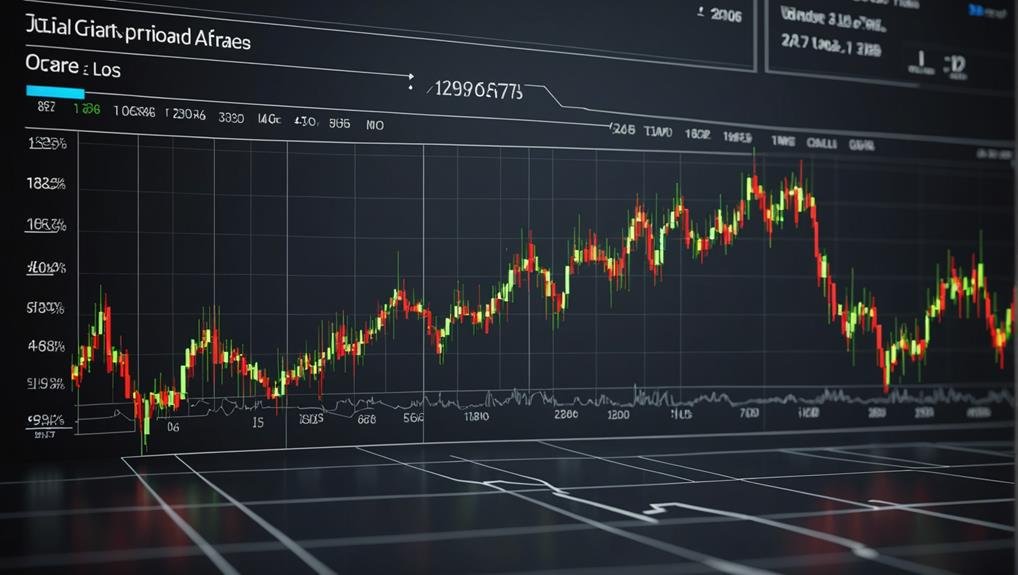What Is the Dow Jones Industrial Average (DJIA)?
The Dow Jones Industrial Average (DJIA) is a prominent stock market index monitoring 30 top publicly-owned blue-chip companies. Established in 1896 by Charles Dow and Edward Jones, it is an important gauge of market movements and economic health. From its humble beginnings with 12 companies, it expanded to 30 by 1928, representing sectors like technology, healthcare, and finance. Calculated using a price-weighted method, DJIA's value reflects the performance of its components. Explore further to uncover its historical milestones, limitations, comparison to S&P 500, and its critical role as a market barometer.
Key Takeaways
- DJIA tracks 30 major publicly-owned blue-chip companies.
- It serves as a key indicator of market trends and economic conditions.
- Created in 1896 by Charles Dow and Edward Jones.
- Calculated using a price-weighted methodology.
- Widely followed for its influence on investment decisions and economic outlooks.
DJIA Definition and Origin
Investigating the definition and inception of the Dow Jones Industrial Average exposes its foundational role as a key stock market index tracking 30 prominent publicly-owned blue-chip companies. This index, created in 1896 by Charles Dow and Edward Jones, serves as an important indicator of market trends and economic conditions.
Originally consisting of 12 companies, it expanded to 30 by 1928 to reflect evolving economic indicators. The DJIA's components encompass varied sectors such as railroads, cotton, gas, sugar, tobacco, and oil, providing a thorough view of market performance.
Regular evaluation ensures the index remains relevant, with recent additions like Walgreens Boots Alliance and Salesforce reflecting contemporary economic trends. The DJIA's historical significance lies in its ability to capture market movements and serve as a barometer of the broader U.S. economy.
DJIA Composition and Evolution
The composition and evolution of the Dow Jones Industrial Average (DJIA) showcase a dynamic reflection of changing economic landscapes and market trends.
- Evolutionary Changes: The DJIA has evolved from its initial 12-company composition in 1896 to the current 30-component index by 1928, reflecting the evolving market dynamics and economic shifts over time.
- Sector Diversification: Over the years, the DJIA has aimed to diversify its components across various sectors such as technology, healthcare, consumer goods, and finance to mitigate sector-specific risks and provide a more balanced representation of the market.
- Regular Reevaluation: The index undergoes periodic reevaluation to uphold its relevance and accuracy, with components being replaced to adapt to the changing business landscape and economic conditions.
DJIA Calculation and Methodology
Periodically reevaluated for accuracy and relevance, the Dow Jones Industrial Average (DJIA) utilizes a price-weighted calculation methodology to track the performance of 30 large, publicly-owned blue-chip companies.
Unlike market capitalization-weighted indices, the DJIA's calculation is based on the stock prices of its components. The index uses the Dow Divisor concept, which is a constant that accommodates stock splits, dividends, and other corporate actions to guarantee continuity in the index's value over time.
This method means that stocks with higher prices have more influence on the index's movements, regardless of the company's market capitalization. The DJIA's price-weighted calculation provides a unique perspective on the stock market, reflecting the performance of these select companies in a straightforward manner.
DJIA Historical Milestones and Events
Throughout the history of the Dow Jones Industrial Average (DJIA), several significant milestones and events have shaped the landscape of the stock market.
- The DJIA reached the 30,000 level for the first time in November 2020, reflecting market optimism and economic recovery.
- Black Monday in 1987 saw the largest one-day percentage drop in the DJIA's history, highlighting the volatility and risks of stock market fluctuations.
- Breaking the 15,000 mark for the first time in May 2013 showcased the index's ability to reflect economic growth and investor confidence.
These DJIA milestones underscore the index's role as a barometer of market sentiment and economic conditions, capturing both highs and lows in the stock market's journey.
DJIA Limitations and Criticisms
Amidst its widespread recognition in American finance, the Dow Jones Industrial Average (DJIA) faces notable criticisms and limitations stemming from its unique characteristics.
One significant criticism is its price-weighted calculation method, where stocks with higher prices have more influence regardless of their market capitalization. This approach can skew the index's movements and not fully represent the market's overall performance.
Additionally, the DJIA's limited composition of 30 companies excludes a broader range of market players, leading to a lack of diversification. Unlike market capitalization-weighted indices like the S&P 500, the DJIA does not consider the total market value of its components, which can impact its accuracy in reflecting the broader market trends.
DJIA Vs. S&P 500: a Comparison
Comparatively, the Dow Jones Industrial Average (DJIA) and the S&P 500 represent two distinct indices that serve as fundamental benchmarks in the domain of U.S. stock market analysis. When comparing the two indices:
- Market Representation, Diversification:
- The DJIA tracks only 30 large, blue-chip companies, while the S&P 500 covers 500 companies, offering a broader representation of the market.
- The S&P 500 includes companies from various sectors, providing better diversification compared to the DJIA's focus on specific industries.
- Index Weighting, Stock Selection:
- The DJIA is price-weighted, giving higher-priced stocks more influence, whereas the S&P 500 is market-cap weighted, where companies with higher market capitalization have more impact.
- The DJIA's stock selection is subjective and based on the editors' discretion, while the S&P 500 follows specific rules for inclusion.
- Overall Comparison:
- The S&P 500 is often considered a more accurate reflection of the broader U.S. stock market due to its diversified composition and market-cap weighting methodology.
Significance and Role of DJIA
In the domain of U.S. stock market analysis, the Dow Jones Industrial Average (DJIA) plays a pivotal role as a barometer of the performance of 30 large, publicly-owned blue-chip companies, offering valuable insights into the overall economic landscape.
The DJIA's significance lies in its ability to reflect market trends and provide a snapshot of the economy's health through the performance of major U.S. sectors. As one of the most widely followed stock market indices, it serves as an indicator of market sentiment and investor confidence, influencing investment decisions and economic outlooks.
While critics point to its limitations, such as its price-weighted calculation and exclusion of many companies, the DJIA remains an essential tool in evaluating the performance of the U.S. stock market.
Conclusion
In the intricate dance of the stock market, the Dow Jones Industrial Average stands as a crucial beacon, guiding investors and economists alike through the ebb and flow of economic tides.
While not without its limitations, the DJIA remains a symbol of American economic prowess and resilience, reflecting the ever-changing landscape of industry and commerce.
As markets shift and trends emerge, the DJIA continues to serve as an essential tool in understanding the complex web of financial markets.







